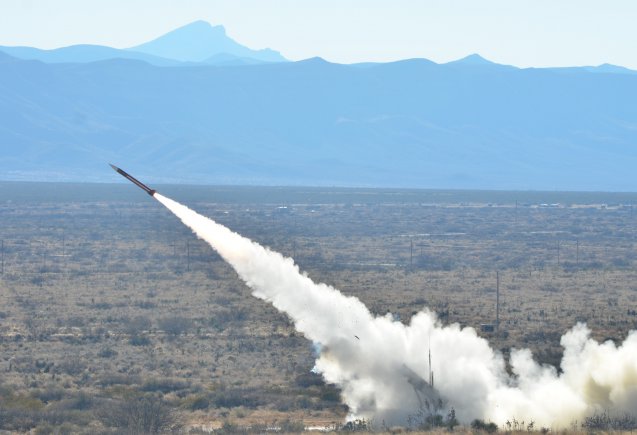Joint Staff Studies New Options For Missile Defense
Posted on

CAPITOL HILL: Minds are changing inside the Pentagon when it comes to the best ways to stop missile attacks, the Army’s top missile defender said this morning. It’s not just that the Joint Staff is conducting a major study of the subject, due out next month, said Lt Gen. David Mann. It’s that a “holistic” array of new options is on the table, from lasers to cyber attack to jamming to preemptive strikes.
Particularly tricky are actions taken “left of launch,” before the enemy missiles leave the launchpad. The best defense may be a good offense, but that raises the unsettling possibility that the US might strike first. Now, Mann told an Air Force Association breakfast, the reluctance to discuss such options is going away.
“When you talk about left of launch and taking actions in a proactive manner, that comes fraught with a lot of policy issues,” Mann said. “[But now] we’re seeing a lot more openness to really discuss that especially at the department level, to really look across the whole spectrum of options.”

Lt. Gen. David Mann
“I see a lot more interest and willingness to discuss left of launch than I’ve ever seen before,” Mann went on. “When you hear the Joint Staff and others talking about holistic, non-kinetic, left of launch [options], you know you’re gaining some ground.”
That said, no less a figure than the outgoing Vice-Chairman of the Joint Chiefs, Adm. Sandy Winnefeld, has urged caution. “While we would obviously prefer to take a threat missile out while it’s still on the ground, what we would call left-of-launch, we won’t always have the luxury of doing so,” Winnefeld warned at the Center for Strategic and International Studies in May. “We don’t want there to be any doubt about our commitment to having a solid right-of-launch capability.”
“Of course, it’d be great to do, to the extent we can,” CSIS’s Tom Karako told me. “[But] SCUD hunts are hard, requiring lots of intelligence and speed: just ask the Saudis and other coalition partners, 50 of whom died last week from a Yemeni missile strike that they missed hitting on the ground. And…it can look like preemption, so policy could impede fully employing such capabilities.”
“All we’re doing is we’re adding more arrows to the quiver and more capabilities for the warfighter,” Mann told me after his public remarks. Left of launch is just meant to be one option among others — but we really need more options.
With our current missile defenses, which rely on shooting down the incoming weapon — usually pretty close to the target — “we’re always kind of on the receiving end,” Mann told me. “We have SM-3s, we have THAAD, we have Patriot, and basically we’re waiting for it to hit us.”
“What we’re trying to do is say, ‘hey, warfighter, we have ISR [intelligence, surveillance, and reconnaissance] capabilities, we have indications and warning, we have other non-kinetic capabilities out there that you can leverage,'” Mann went on. “At the end of the day, whoever’s in charge of the campaign is the one that’s going to see what gets employed.”
Mann was characteristically cagey about just what those unspecified “non-kinetic capabilities” might be. He did make clear that real-world capabilities exist today in both electronic warfare — e.g. jamming enemy sensors and communications– and cyber warfare — hacking enemy networks and electronics. But he couldn’t tell the open forum much more without losing his job or going to jail.
Communicating about these capabilities is difficult even within the military, Mann told the group. “The challenge that we have, quite frankly, with some of these programs is they’re extremely compartmentalized and they have a very high classification level,” he said. “How do we ensure that the COCOMs [combatant commanders] are aware of these capabilities?… .We’re working our way through.”
Again, CSIS’s Karako added a note of caution. “There’s a lot of momentum and interest surrounding directed energy [e.g. lasers], cyber, and the larger spectrum of electronic warfare for missile threats,” Karako told me. “This is all good stuff when we can make it work, but it sounds like we’re not there just yet.”
“So it’s not unreasonable to ask whether investments in these bright shiny objects could detract from other medium-term investments, as well as incremental but less exotic improvements to existing systems,” Karako continued. “As just about anyone will say when pressed, for the immediate future we’re likely still going to need lots of chemically-powered hit-to-kill systems with long legs” — i.e. interceptors.
It’s just that interceptors alone are no longer enough, if they ever were. “Gone are the days where we could simply provide enough interceptors to address all the threat vehicles that are out there,” Mann said. “We’re faced with relatively inexpensive ballistic missiles and cruise missiles, and as good as our interceptors are, we’ll never have enough.”
“At least 22 countries” now have ballistic missile capabilities, Mann said. Nine are working on cruise missiles. The Chinese have conducted more than half a dozen tests of hypersonic weapons that could race through our defenses faster than we could react.
Last year, Army Chief of Staff Ray Odierno and Chief of Naval Operations Jonathan Greenert wrote a memo to Secretary of Defense Chuck Hagel, saying the demand from theater commanders for missile defense units was outstripping their services’ supply. (All three men have since retired or left). There has to be another way, the two four-star officers said. That message was heard loud and clear at the highest levels, Mann said, and it led to the “Joint Capabilities Mix Sufficiency Study” expected to conclude next month.
Subscribe to our newsletter
Promotions, new products and sales. Directly to your inbox.
